Watch this space for a series of posts written by Fall 2020 and Spring and Fall 2021 Interns! We start with some more recent interns from Fall 2021, and will feature them all, so please keep checking!
Rachel Burdette: Champaign County History Museum

In Fall Semester 2021, was lucky enough to work on social media and outreach for the Champaign County History Museum. I was responsible for creating content for the museum throughout the semester on Facebook, Instagram, and Twitter, and engage directly with the community. The museum had very little content previously, so I was trying to post consistently 4-5 times a week. I was free to design and create my own content, which was daunting at first with all the possibilities. However, I was able to research local history I was interested in and try to understand the content people enjoyed the most. It was a very interactive learning process, getting direct feedback from the public in the form of followers, likes, comments, and shares.
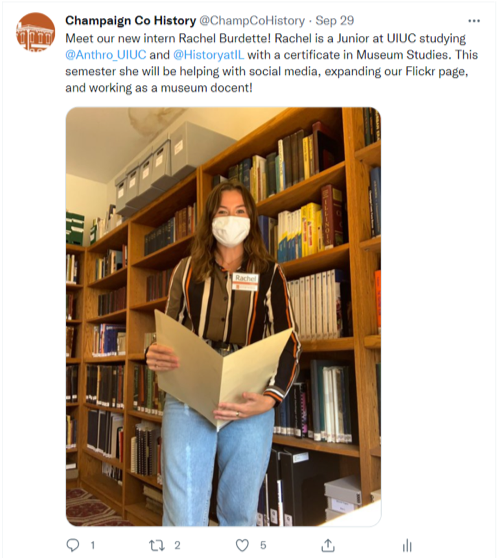
Sometimes I struggled with creating content that was both engaging and informative; I read The News Gazette and Smile Politely frequently to see if there were any local events that could be tied into the museum’s content. I wanted to create content that was involved with current events, but without taking away from the goal of social media: increasing awareness of the museum. This meant that all the content needed to be related to the mission of the museum, but that did not mean that I was limited to the exhibits, or even the artifacts in storage. I looked for old photographs, even contacting an archive in Nebraska for a photo to post about taffy pulls in Champaign County. I tried to work outside of the box, while also still catering to an older demographic, who value more traditional concepts of historians and museums.
Social media work is incredibly important in the current field of public history. It engages the public in an easy, informal setting and allows transparency between institutions and the communities they serve. This work is deceptively difficult and time consuming. Research and thought needs to be put into each post – and people will call you out if it doesn’t meet their standards! There is a learning curve with writing for a general audience on social media, and it changes depending on what platform is being used. It can be easy to create content that you find interesting, but if the public isn’t engaging with it, new strategies need to be adopted. I needed almost a month to find my voice for the museum that the public also liked and found engaging. I thoroughly enjoyed my work with the Champaign County History Museum, and learned many lessons during my time there.
John Byer: Champaign County History Museum
Hello All,
I am John Byer, a senior at UIUC with a major in History. I originally chose to intern at a museum because of my interest in history: I wanted to broaden my horizons of careers that don’t involve being a teacher. I had previously taken a course on museum studies and remembered the enjoyment I had going t museums in in Chicago, so thought I would try it out to gain some experience. I interned at the Champaign County History Museum and found the experience very rewarding as well as challenging. Through this experience, I learned a lot more about working in a museum including the day-to-day as well as the big-picture overarching goals.
For example, in the day-to-day, I did a lot of important but menial work like cataloguing new documents and artifacts or updating older catalogue entries. Although this was not the most exciting work, it taught me about the software and procedures for handling museum artifacts. This helped illuminate the museum’s larger context, as any museum will have a collection that has new items coming in or old artifacts going out. Another job I handled was digitizing oral histories. This was a fairly unique experience as I had to to change the format of old tapes into mp3s. The oral histories were pretty fun, as you never knew what you would get from tape to tape. The tapes went from people talking about their old houses and friends to some people doing stand-up comedy in an old bar.
One of the largest projects I worked on was the creation of a new exhibit for the museum. I found the exhibit work to be some of the most rewarding and challenging. I was tasked with creating an exhibit on the Urbana Pure Milk Company. It was a demanding project as I had to do research in local archives and then draft the information into labels. However, it was rewarding to construct a new exhibit and put it on display for guests to view a piece of locla history that they may not have seen or remembered in a long time. I also worked as part of the education committee looking at the bigger picture of how the museum could draw in more people and audiences. Appealing to a broader audience is a challenge all museums face. My experience in the museum helped me contextualize how museums work to better fulfill the needs of the public and the museum as an institution.
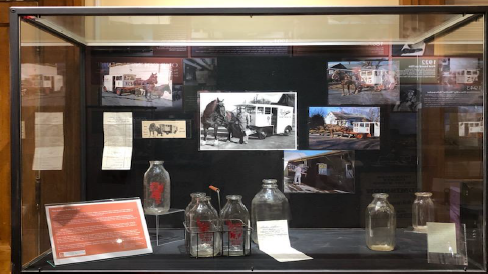
Azaan Qureshi: My Experience in a Public History Internship, Fall 2021
As a senior studying History at the University of Illinois, I wanted to engage History in a way that went outside the classroom and writing papers about things I could only connect myself to through books or libraries. Looking for such an opportunity, I gained an interest in public history and was eager to learn more about what it was. Additionally, I always wanted to get experience with museum work. The Champaign County History Museum check off both boxes for me.
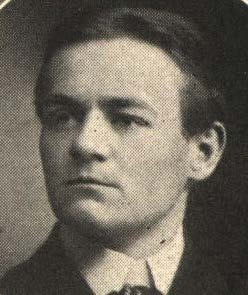
In my internship at the CCHM, I was given the responsibility of curating a digital rendition of the in-person exhibit, “Zuppke en La Playa: Sketches of a Gridiron Great.” This exhibit is a showcase of the work of Robert Zuppke, University of Illinois football coach, philosopher, and painter. The exhibit at the museum addresses his accomplishments as a football coach in great detail. But it also pays special attention to sketches that he did during his time in Havana, Cuba in 1946. My goal for this project was to showcase these sketches in a clean, attractive, and easy to follow digital format utilizing the Omeka platform.
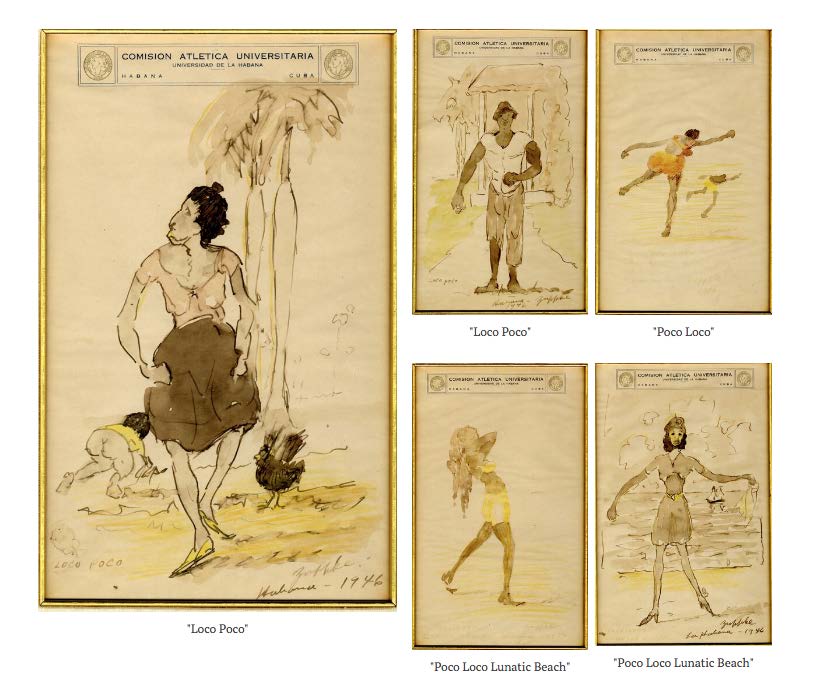
I learned a great deal during this internship. I can honestly say that the people I met at the museum and the experience I had working within the realms of public and digital history is one of the most rewarding and enjoyable experiences I have had since coming to the University of Illinois. During the semester, i learned about Dublln Core metadata and its various elements, I mastered the Omeka platform on which I built the digital exhibit, and learned a lot about Robert Zuppke himself. Having known nothing about him going into the project, I gained a great respect for him and enjoyed reading his “Zuppkeisms.” Additionally, I got insight into what it is like to work in a museum setting by working on my own project and learning from the other interns and staff memebers who run the museum. I learned I had a great interest in this work, and I definitely would consider working in a museum again.
The challenges I encountered were easily overcome. The greatest challenge I faced was in making something that the general public would find enjoyable and nice to look at. I wanted to make sure my digital rendition did justice to Robert Zuppke’s accomplishments and compelled people to keep reading through each section. Finding that balance between readability and form was difficult, but I succeeded by simply taking a step back and asking myself, “would I even read this to the end myself?” By the time I finished my project, my answer was a resounding yes and I was very proud of the work I produced.
I see this experience relating very significantly to the broader scope of history. As we move into an increasingly digital and online world, digital history is becoming a bigger field. By exploring the possibilities of digital public history it becomes apparent that media like Omeka and even social media platforms will serve an indispensable role in history for years to come. You can reach a much bigger and broader audience digital, or you can cater to a smaller and specific audience. Because you can do either in the digital space, I think digital media will be very important in reaching the audiences public history is made for.
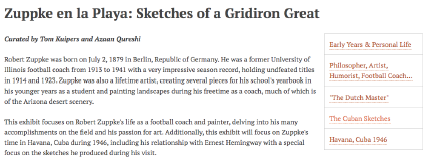
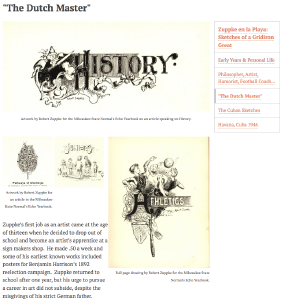
PUBLIC HISTORY INTERN BLOGS RETURN! First, some seniors….
It’s been a busy year in the Public History Intern Workshop. History students have continued to seek out varied intern experiences on and off campus. Their efforts, as these blogs attest, were complicated by COVID-19, as access to archival materials and sometimes even museums themselves evaporated. But they rose to the challenge and learned to use on-line resources to construct new histories for the Illinois Distributed Museum, local history museums in Champaign-Urbana and other Illinois cities, and even a local Refugee Center. In this set of blog-posts, we feature reflections on this experience from seniors who participated in the workshop in the Spring and Fall of 2020. (the workshop each participated in is indicated after the title). There are also seniors in the Spring 2021 workshop who are constructing their blog posts now. Look for those just after graduation! Then, we’ll also feature the blogs of those 2020-2021 interns who we will be fortunate enough to still see around for a year or two. Congratulations all on their work in, and insights into, the field of public history!
Mary Danner: Immigrant Histories and the Refugee Center (Sp 20)

My mother is one of the many immigrants to have made their home in Champaign-Urbana, and knowing where you came from has always been an important landmark for my family. My mother, as part of the post-war Irish diaspora, came to America on one of the last boats through Ellis Island. This has been a source of great pride but also sorrow for my mother. I was raised on stories of her time both in rural Ireland and in Chicago–how as a toddler, never having seen so many people, cars, and lights, she broke away from my grandparents and ran across Time Square. These personal histories are integral to me and my worldview and, as I grew up, easily transformed into a broader love of and dedication to history.
In 2018, I began working for the Refugee Center as their administrative assistant. As a history undergrad participating in the Public History Internship Program and a member of the Refugee Center staff has offered me a unique opportunity. Looking at the history and workings of a local nonprofit from the inside, and examining how public history intersects with other public services has been eye opening. Public history has an important role to play beyond the walls of museums and archives. My original project, to research and write a history page for the Refugee Center’s new website, was interrupted by COVID-19. Many nonprofits, big and small, are in charge of writing and preserving their own histories, as well as the histories of the communities they serve. There are many people who have been involved in the center’s history at one point or another that are still active members of the Champaign-Urbana community. You may have heard about the Refugee Center from one of them. Word of mouth has long been a powerful tool in non-profit work generally, and it has always been especially vital for immigrant services. The Refugee Center was founded in a time when newspapers and physical newsletters were the primary means of communicating to the wider community. But we have moved into a new age of information sharing and it is important the Refugee Center establish itself with these new lines of communication.
There is a lot to learn about local, immigrant, and local immigrant history from the Refugee Center. The center was founded in 1980 by a pair of Vietnamese refugee women, and since that time has opened its doors wide to the ever more diverse and thriving community of immigrants and their families in Champaign County. Throughout the COVID-19 crisis, the Refugee Center has worked hard to continue supporting immigrants in Champaign County (as well as the wider East Central Illinois Area) by providing relief to many clients through direct financial assistance, continuing services, and other outreach. The role the Refugee Center (alongside many other similarly dedicated agencies) is filling during this crisis reaffirms the need to recognize and record the role agencies like this play in their communities.
Much of my research was to be done in the local Champaign County Historical Archives, which got put on hold when the lockdown went into effect. However, our local archive offers a great online catalog to peruse, and through that and other online resources, I was able to put together a project proposal and bibliography, which I will act on once the opportunity is afforded to me.
Savanna Rung: Guided Tour of Disability Activism and Disabled Student Life for Illinois Distributed Museum (F20)
When the COVID-19 pandemic hit in March, most people expected the self-isolation period to only last a few weeks. After that initial period and the realization that this would not be over quickly, I began to panic at the realization that I might not be able to have an internship the summer before my senior year of college. Cancellations of internship programs I’d applied to began to roll into my email inbox. Luckily, what also arrived in my inbox was a newsletter advertising that the Illinois Distributed Museum was seeking interns. I reached out and to my delight, I was accepted. Not only that, I was able to do the internship digitally, meaning the upmost possible safety for me and the family members I was living with. It was the ideal scenario given the unfortunate situation. I would get to have an internship after all, and it would be in public history and museum work like I’d hoped.
The Illinois Distributed Museum is an online resource for self-guided tours on the history of the University of Illinois. As an intern for IDM, I was responsible for writing and researching some of these tour stops, including a short history and description of the stop and its history at the university, the physical location it would be associated with, and a corresponding picture related to the history discussed. I began the internship by choosing a topic. I chose to focus on the university’s history of disability advocacy and the achievements of disabled students. It was a new topic for me and as a result I learned so much about disability activism, both at the university and at large. Then, I was given a topic for each tour stop I was assigned, paced at one stop per week over the course of the summer. This meant that as long as I was able to meet the expected deadlines, I would have the freedom to choose when I would do my work. Conversely, this also meant that I was accountable for setting a schedule for myself and sticking to it. As a result, I strengthened my work ethic and improved my ability to keep a work schedule. Researching university-specific topics also led me to utilize databases that I had not yet used, occasionally running into roadblocks when certain archives were not yet digitized. This definitely taught me to approach research in a new way and to develop creative solutions to problems. Additionally, IDM’s function as a public museum required me to adjust my writing style to be accessible to everyone. It allowed me to reflect on my communication style and make sure that the way I convey information is effective.
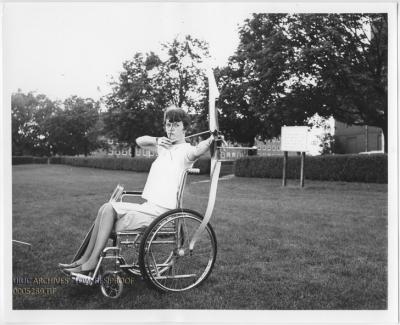
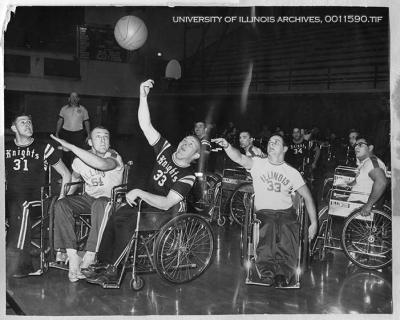
Overall, interning with the Illinois Distributed Museum was an absolutely fantastic opportunity that I am so grateful for. It has strengthened my skills as a history student and given me a newfound appreciation for the university I attend. The structure of a physical tour helped me to connect the history I was learning to the physical world around me. It pushed me to improve my communication and organization skills. Most of all, it reminded me why history is so important and why I chose to study it in the first place.
Luke Anthenat: Engineering and Technology Exhibits for the Illinois Distributed Museum (Sp20)
This Spring I began an internship with the Illinois Distributed Museum as a sort of research assistant. The point of the Illinois Distributed Museum is to act as a gathering point for the collective knowledge of the University of Illinois. Hosted within the main library archive, the IDM hopes to share information and stories about innovation and innovators related to the university, from whipped cream to the LED and everything in between.
My work for the IDM was fairly straightforward, over the course of the semester I was to select four examples of innovation from the university and write short informative labels about them which would mimic the labels found in traditional museums. My exhibits were meant to showcase information, pictures, scholarly sources, and additional links and locations for readers who might be interested in learning more about the topics that I wrote about. At first, I found the idea of writing for future audiences daunting, and while I am still by no means comfortable with it, I have slowly gotten more adjusted to it as I have worked on my four exhibits.
For my internship I wanted to try and focus my exhibits on innovations within fields that I am more familiar with, such as engineering and technology. My first exhibit was on an invention called “The Smart Ice Management System”. The system was an experimental method for airline pilots to receive real time data which could help them to counter the effects of ice build-up on the outside of planes. This exhibit was interesting to work on, but a lack of available information made it a little difficult when it came to the early stages of information gathering. My second exhibit was on “Quantum Dot Imaging”, which is an experimental imaging system within biomedical engineering. Quantum dots are incredibly small balls which could be put into a patient’s body, either through injection or ingestion, and would emit light that could be photographed by doctors. In theory these dots would allow for better quality pictures than current methods of internal imaging and would aid future health care professionals in early discovery of potentially life-threatening diseases and conditions. My third exhibit was about “George W. McConkie and his Eye Tracking Research”. A professor at the university of Illinois, McConkie used eye tracking software in the hopes of learning how humans learn and retain information while reading. My fourth and final exhibit was on the “Krannert Performing Arts Center”, which has been described as having some of the best acoustics in the world and has hosted some of the most famous musicians and performers in the world.
Midway through my internship, the world was struck with the outbreak of the COVID-19 virus, and almost all aspects of life were changed. From my perspective as a student, I was forced to return home to my parents’ house and continue my schooling through and online format. There is no easy way of saying this, but online schooling is largely ineffective, and I cannot help but feel as though the second half of this semester was just one long and not very funny joke. From the beginning, my internship was conducted online, so my ability to do my work was largely unchanged, however, what I felt was a severe decrease in my overall motivation. After speaking with the other interns for the IDM, it seems as though many of us were faced with this same issue. While at school, we are under the watchful eyes of professors and university staff, but at home, we are more or less on our own, and as a result, my found my willingness to do work decrease drastically. Beyond motivation, I found myself struggling to write about events and places in a town that I was no longer living in and therefore felt less of a connection to. While writing my exhibit on the performing arts center I found myself spending hours looking at pictures of the interior and exterior of the incredibly beautiful building and wishing that I could go there and see it again, all the while knowing that it was closed indefinitely.
As a whole, this internship experience has made me realize how valuable it is to have access to things like museums online for everyone to see. My hope for the future is that more museums and public spaces will begin to adopt accessible online practices and backups in the event that the future sees public spaces become less public again.
Zachary Schmitt: Histories of the School of Music for the Illinois Distributed Museum (F20)
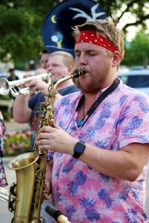
My own fascination with History began sitting on my grandpa’s lap and hearing stories about the world he grew up in, where it took three sets of tires to get the family to vacation at Pike’s Peak in Colorado and Great Grandpa flipped his car into the ditch to slow erosion on the family farm during a particularly heavy rainfall. My fascination grew deeper when I was exploring some local woods near my childhood home and stumbled upon an overgrown cemetery. Instead of being scared like the rest of my young peers, I realized I only wanted to know the stories behind how it got there, why it was neglected, and if it had anything to do with the former lead smelting operation our neighborhood was built on. As I grew up, I realized the information I was being presented was never enough for my own curiosity. I wanted to know far more about the story behind an event, place, or thing instead of simply what it was as so many of my peers seemed satisfied with. Because of this, after flirting with different fields of interest, I came back to my fascination with storytelling, and my belief that telling stories of the past drive us forward as a people and keeps us grounded with the ideas that came before us.
I completed my internship at the Illinois Distributed Museum during the Fall of 2020 With it being 2020, this obviously means my internship was inseparable from the strain all the events that 2020 has brought the world. But with the museum itself being online regardless of the state of the world this meant that my internship was largely unchanged from what it would’ve been with or without the effects of COVID-19. While the largest loss from the COVID-19 crisis on my internship was my ability to readily access information from many of U of I’s physical archives, it encouraged me to dig much deeper online. The largest benefit from this was that my exhibits can feature more resources that visitors looking for a deeper understanding than the general public can readily find even if I was not able to gain as much personal experience with physical archives.
Another major positive aspect of completing my internship with the Illinois Distributive Museum was that the history of the University of Illinois is so diverse that I was able to combine my interest in music with my love of history and storytelling to focus histories within the School of Music here at Illinois. My specific studies focused on Bruno Nettl’s life and Paul Rolland’s String Project. While I certainly relied on a substantial amount of information about their most famous accomplishments, I was able to use my own approach to ensure I could tell part of the story of these pioneers as people instead of just a list of accomplishments. The freedom and open-endedness granted to me as an intern allowed me to take a topic and ensure my voice would always be present in my work as one of the most rewarding experiences of my academic and professional career.
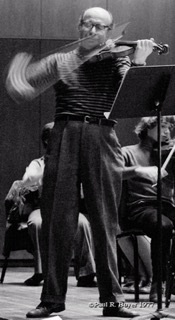
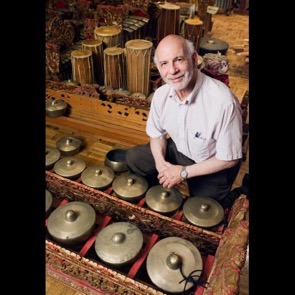
Maddy Kienzle: Illinois Distributed Museum Exhibits on Medical Innovation (F20)
I don’t remember a time when I was not interested in history. Learning about the different cultures and civilizations developing across the world has always captivated my attention. But it was not until I got to the University of Illinois that I learned the importance of history. “The more you know about the past, the better prepared you are for the future.”(Teddy Roosevelt) I learned that some of the mistakes of societies in history have had massive repercussions. I also learned that it is not until a person understands the full effect of those repercussions that we develop a way to correct current problematic scenarios. So, when I found the Illinois Distributed Museum I was intrigued and excited.

When I applied to be an intern at Illinois Distributed Museum, I anticipated that I would learn about the different inventions and innovations at the University of Illinois. I did not anticipate learning about how part of the
innovations at the University were due a complete change of thought processes especially in the medical field.
One of the topics I researched was PAC-1–an anticancer drug originally designed for dogs. PAC-1 was innovative on all fronts. It was one of the first drugs that was tested on animals with cancer. Most anticancer drugs were developed by injecting mice with cancer and going from there. Innovative thinking continued with redeveloping and adjusting the anticancer drug to help late stage cancer patients. This drug helped to develop a completely different blueprint to developing antibiotics.
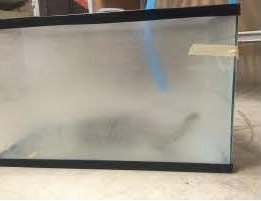
As my research continued, I realized that this was not a unique case of innovative thinking. In the case of nebulizer treatment for venomous snakes, they developed a treatment that had additional therapeutic benefits. Not only did the new treatment have additional benefits, but it was also less invasive and easier to administer to the infected snakes. Although medical innovations to the process and development of a drug are important, the mindset is just as valuable. In my final days researching, I learned about changing the approach to a patient to be inclusive to different cultures and financial background is extremely important for proper care. I learned about the impacts of not regarding the stigmas surrounding mental health and the repercussions of social inequality. Before my involvement with this program, I did not understand the magnitude that carefully concerning these issues can have.